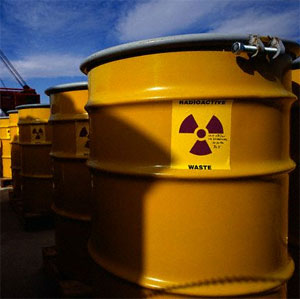Similar to carnivorous plants, an innovative material, developed at Northwestern University, permanently captures only its desired prey - the radioactive ion cesium, and not other harmless ions, such as sodium

Similar to carnivorous plants, an innovative material, developed at Northwestern University, permanently captures only its desired prey - the radioactive ion cesium, and not other harmless ions, such as sodium.
The synthetic material, which consists of layers of a gallium compound, sulfur and antimony, is extremely selective. The researchers found that it is very effective in removing the substance cesium - found in nuclear waste and problematic for cleaning - from a concentrated solution of sodium ions (the solution had concentrations similar to those found in actual liquid nuclear waste).
In fact, it is the cesium itself that is responsible for a structural change in the material, a change that causes it to open holes, or windows, and capture the cesium ions through them. The new material managed to remove one hundred percent of the amount of cesium ions in the tested solution while completely avoiding the capture of sodium ions. The research findings were published in the scientific journal Nature Chemistry.
"Ideally, we would like to concentrate the radioactive material separately and treat it properly and throw away the non-radioactive water," the researchers explained. "This new family of materials, which utilizes the mechanism used by insectivorous plants, could lead to a significant breakthrough in nuclear waste recycling."
Exclusively capturing cesium from large quantities of liquid nuclear waste is like finding a needle in a haystack. In waste there is a higher concentration of sodium relative to cesium, with a ratio higher than one thousand to one. The difficulty of achieving such selectivity is the reason for the current situation, where there is no good solution for cesium removal.
The innovative material is porous, and its atoms are organized in an open and layered format with many "windows" that aid in rapid ion exchange. Initially, organic cations are present in the material; When the material comes in contact with the liquid, the cations "leave" the material through the windows, and the cesium ions replace them. Ultimately, the material contains only cesium ions and no organic cations.
This mechanism occurs because "soft" materials tend to react with materials of the same type. Cesium ion is bulky and "soft" and so is the new material, which contains metal and sulfur. The cesium ions are attracted to the material, especially the sulfur atoms, forming weak bonds with them. This reaction causes the material to change its structure, to close its windows and thereby trap the cesium ions - like a juicy insect trapped in a carnivorous plant. Sodium ions, "wrapped" in water droplets, on the other hand, cannot trigger this reaction.
Initially, the team of researchers in general examined different structures of the material to test its activity as an ion exchanger. "When we saw the windows closing - it was completely surprising," notes the lead researcher. "We expected to get ion-exchange - we didn't expect the material to react in such a dynamic way. This led us to focus on a new mechanism."

6 תגובות
That's a really good question. Why can't the radiation of the nuclear waste be converted into energy?
So why not continue to extract energy from it in some way? Isn't it better to focus in this direction?
Now I read in TOMSHARDWARE that there is a new gadget that charges a cell phone in 90 minutes from WIFI waves, so why can't radiation from radioactive material be used?
Maybe if they put all the nuclear waste in the world in one place it would create something that could be used to continue producing energy, wouldn't it?
Nice article, and interesting research. Let's hope it won't be long before the new material comes into commercial use.
@Ishmael:
Such a course of action will not allow us to settle the area in the future. 🙂
Better to throw the nuclear waste in Gaza...
Are there plants that can eat humans??
A nice solution for an environmentally friendly burial....:)
It is possible to do a XNUMX-year-old in a tribe in Gaza and plant them in Gaza